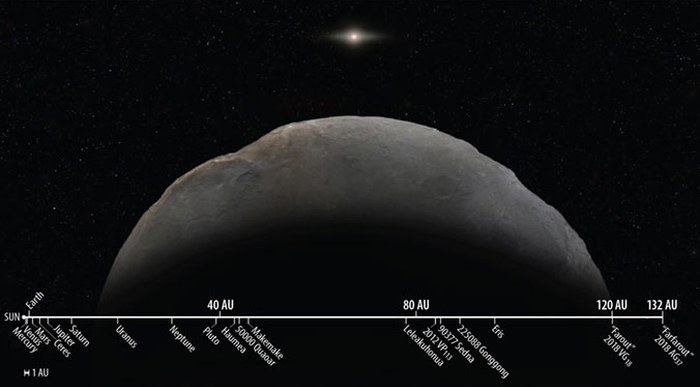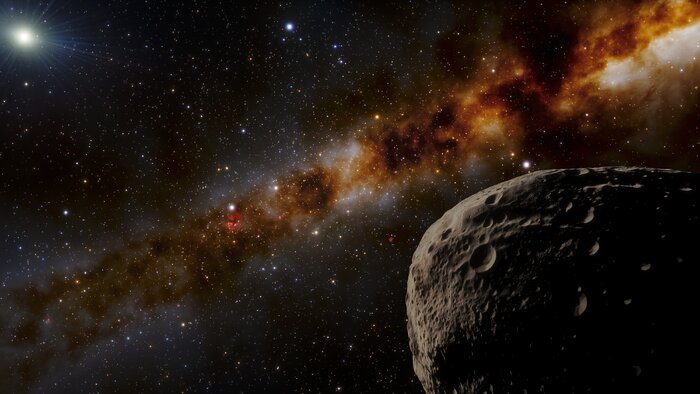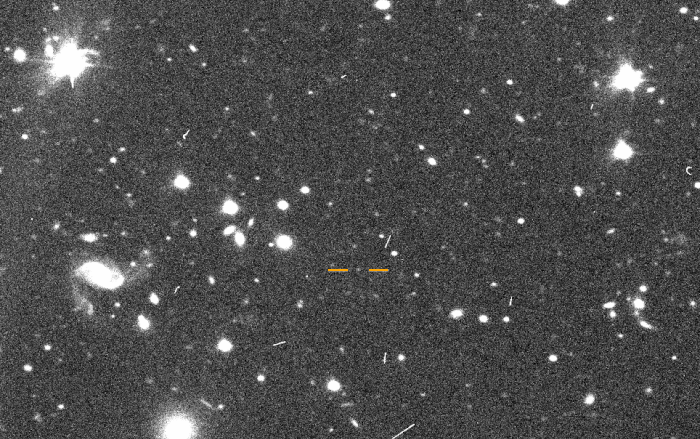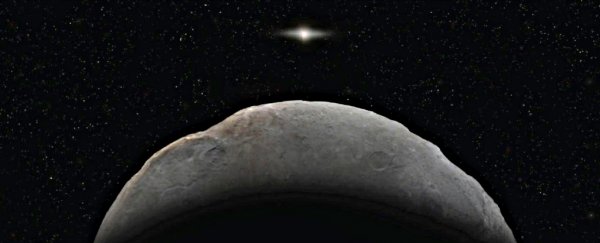The most distant known object in the Solar System is now confirmed. FarFarOut, a large chunk of rock found in 2018 at a whopping distance of around 132 astronomical units from the Sun, has been studied and characterised, and we now know a lot more about it, and its orbit.
It's about 400 kilometres (250 miles) across, which is on the low end of the dwarf planet scale, and initial observations suggest it has an average orbital distance of 101 astronomical units - that's 101 times the distance between Earth and the Sun.
Since Pluto has an average orbital distance of around 39 astronomical units, FarFarOut is very, well, far out indeed. It has been given the provisional designation 2018 AG37, and its proper name, in accordance with International Astronomical Union guidelines, is still pending.
That orbit, however, isn't an even circle around the Sun, but a really lopsided oval. After careful observation, scientists have calculated its orbit; FarFarOut swings out as far as 175 astronomical units, and comes in as close as 27 astronomical units, inside the orbit of Neptune.
 (Roberto Molar Candanosa, Scott S. Sheppard/CIS, and Brooks Bays/UH)
(Roberto Molar Candanosa, Scott S. Sheppard/CIS, and Brooks Bays/UH)
This means that the object could help us better understand the planets of the outer Solar System.
"FarFarOut was likely thrown into the outer Solar System by getting too close to Neptune in the distant past," said astronomer Chad Trujillo of Northern Arizona University. "FarFarOut will likely interact with Neptune again in the future since their orbits still intersect."
The object's nickname evolved from the discovery of an earlier distant object in 2018.
 Artist's impression of FarFarOut. (NOIRLab/NSF/AURA/J. da Silva)
Artist's impression of FarFarOut. (NOIRLab/NSF/AURA/J. da Silva)
Dwarf planet Farout has an average orbital distance of 124 astronomical units, and it was named after an exclamation made by astronomer Scott Sheppard of the Carnegie Institution for Science. When he and his team discovered an even farther object, the progression was obvious.
FarFarOut is still very mysterious, though. Because it's so far away, it's extremely faint, and has only been observed nine times over the course of two years. The team has inferred its size based on its brightness, but we don't know much else; it could be a very large irregular Kuiper Belt object, or it could meet the criteria to be classified as a dwarf planet.
 Discovery images of FarFarOut obtained in July 2018. (Scott S. Sheppard/Carnegie Institution for Science)
Discovery images of FarFarOut obtained in July 2018. (Scott S. Sheppard/Carnegie Institution for Science)
The astronomers are also not entirely sure of its orbit time. They think it could be could be just shy of 800 years (Pluto's is 248), but there's enough wiggle room for it to take more than twice that time, or possibly move at a much faster pace.
So a lot more observations will have to be made to understand it better.
"FarFarOut takes a millennium to go around the Sun once," said astronomer David Tholen of the University of Hawaiʻi at Mānoa. "Because of this, it moves very slowly across the sky, requiring several years of observations to precisely determine its trajectory."
Sheppard, Tholen and Trujillo are working on studying the outer Solar System in the hope of acquiring a glimpse of Planet Nine, a hypothetical object thought to be responsible for the strange movement of clusters of objects in the outer reaches beyond Pluto.
There are other explanations for these orbits, but the work is having an excellent side benefit. The team has discovered a number of objects we hadn't known about. There's Farout and FarFarOut, of course. There's also a dwarf planet nicknamed The Goblin, discovered at a distance of 80 astronomical units.
There's even an object, named 2014 FE72, whose orbit takes it out farther than 3,000 astronomical units, the only known object of its kind with an orbit entirely outside Neptune's. (It's currently a lot closer after its close approach to the Sun in 1965.)
It's not just the outer Solar System, either. The researchers have discovered 12 previously unknown moons in orbit around Jupiter and 20 moons orbiting Saturn.
So if there is a Planet Nine out there, these appear likely to be the people who will find it. But in the process, they're revealing a heck of a lot about the outer Solar System.
"The discovery of FarFarOut shows our increasing ability to map the outer Solar System and observe farther and farther towards the fringes of our Solar System," Sheppard said.
"Only with the advancements in the last few years of large digital cameras on very large telescopes has it been possible to efficiently discover very distant objects like FarFarOut. Even though some of these distant objects are quite large - the size of dwarf planets - they are very faint because of their extreme distances from the Sun. FarFarOut is just the tip of the iceberg of objects in the very distant Solar System."
